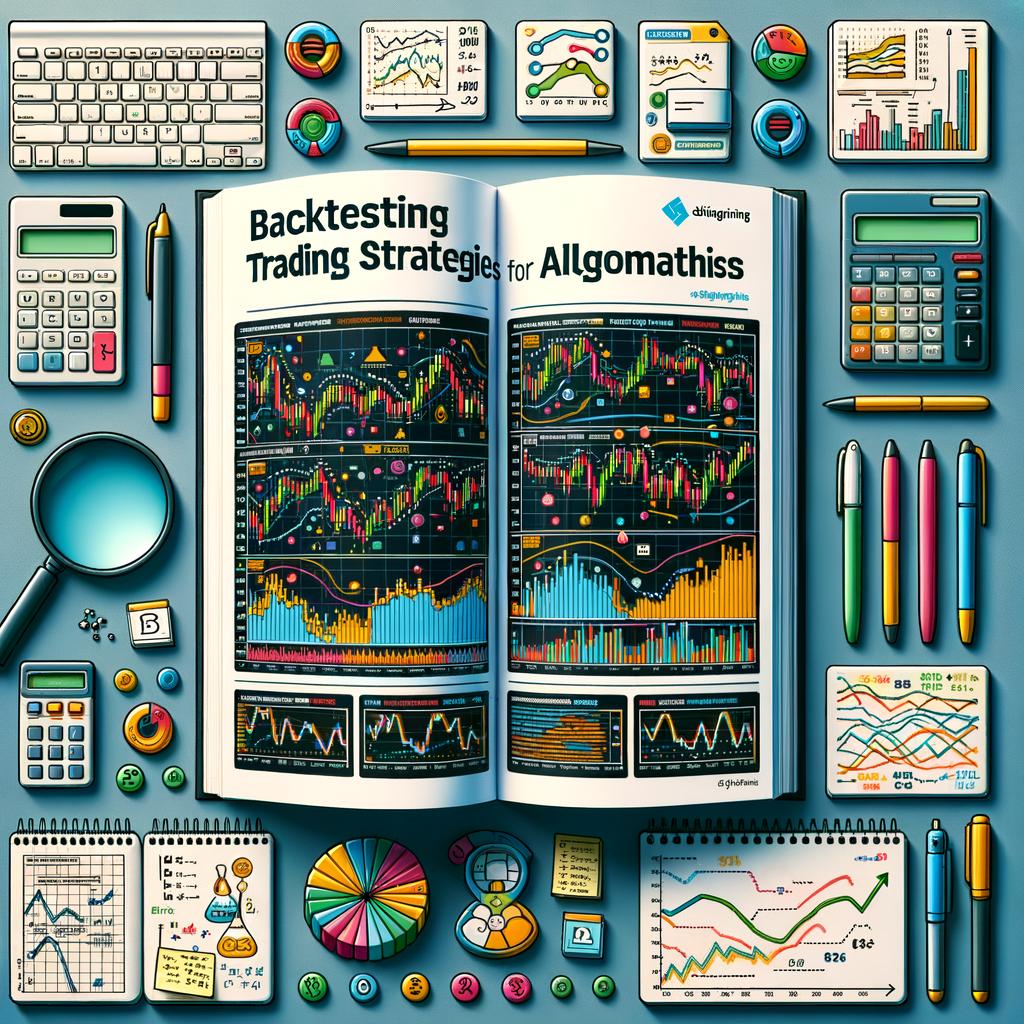In the ever-evolving world of algorithmic trading, the potential for success often hinges on thorough preparation and meticulous analysis. Enter the crucial practice of backtesting, a method that offers a glimpse into how your trading strategy might perform based on historical data. By simulating trades through past market conditions, backtesting allows traders to fine-tune their algorithms, minimize risks, and enhance potential returns. This guide delves into the essentials of backtesting your algo trading strategy, offering step-by-step instructions to help you master this indispensable tool. Join us as we explore how to harness the power of historical data to elevate your trading game.
Understanding the Essentials of Backtesting
Before diving into the world of algorithmic trading, understanding backtesting is crucial. Backtesting allows traders to simulate their trading strategies using historical data. This is essential because it provides insights into how a strategy would have performed in the past, helping traders to refine and optimize their approaches. Backtesting involves several critical elements:
- Historical Data: Accurate and high-quality historical data is the foundation of any backtest. This data should cover various market conditions to provide a comprehensive assessment.
- Trading Strategy: Clearly defined rules and parameters are necessary to evaluate a strategy’s performance. This includes entry and exit points, risk management, and position sizing.
- Performance Metrics: Metrics such as profit and loss, drawdown, and sharpe ratio are vital for assessing the efficacy of a strategy.
| Metric | Definition |
|---|---|
| Profit and Loss | Net income generated over a specified period. |
| Drawdown | The peak-to-trough decline during a specific period. |
| Sharpe Ratio | Measure of risk-adjusted return. |
Conducting a backtest involves replicating trades as precisely as possible to understand how your strategy might perform under real-world conditions. This process isn’t just about verifying potential profitability; it also highlights possible weaknesses. For instance, slippage, which is the difference between the expected and actual trade prices, can significantly impact results. Backtesting helps identify these gaps, enabling traders to adjust their strategies accordingly.
the choice of a backtesting tool can significantly affect outcomes. There are numerous tools available, from free platforms to sophisticated software suites. When choosing a tool, consider factors like ease of use, data integration capabilities, and support for various trading instruments. It’s also beneficial to utilize platforms that allow for both manual and automated backtesting, offering greater flexibility and control.
Choosing the Right Backtesting Software and Platforms
When it comes to backtesting your algorithmic trading strategy, the choice of software and platform is crucial. You need to ensure that the tool you select offers robust features, reliability, and the capability to handle the complexities of your strategy. Here are some key points to consider when making your choice:
- **Compatibility**: Ensure the software integrates easily with your existing trading tools, data feeds, and brokerage accounts.
- **Data Quality**: High-quality historical data is essential for accurate backtesting. The platform should provide comprehensive and clean data.
- **Customization**: Look for tools that allow you to fine-tune your backtesting parameters to suit your unique strategy.
- **Speed**: Efficient algorithms need quick backtesting. The software should offer high-speed analysis without compromising accuracy.
- **Support and Community**: A strong support system and active user community can be invaluable when you encounter challenges.
Let’s take a look at some popular options, weighing their pros and cons:
| Platform | Pros | Cons |
|---|---|---|
| MetaTrader 4/5 | Comprehensive tools, large user base | Steep learning curve |
| TradingView | User-friendly, cloud-based | Limited historical data |
| NinjaTrader | Advanced charting, customizable | Costly for advanced features |
| QuantConnect | Open-source, collaborative | Requires programming knowledge |
Designing Robust Testing Frameworks for Reliability
Crafting a robust testing framework is essential for ensuring the reliability of your algo trading strategy. A well-designed framework should encompass various testing phases including unit tests, integration tests, and simulations. Focus on establishing **clear and concise testing criteria** which addresses potential market conditions and anomalies. Consider incorporating aspects such as backtesting against historical data, stress testing for market turbulence, and forward testing in paper trading environments. Remember, maintaining detailed **documentation** and version control is crucial for tracking changes and optimizing your strategy over time.
To facilitate an efficient testing workflow, leverage existing tools and libraries that are specifically designed for algorithmic trading. Platforms like **QuantConnect** and **MetaTrader** provide ready-made environments for running your tests. Key factors to evaluate during testing include:
- Execution Speed: Ensure your algorithm executes trades swiftly, minimizing latency issues.
- Accuracy: Validate that your algo operates correctly under varying market conditions.
- Scalability: Test whether your system can handle increased trade volume without performance degradation.
Here’s a quick comparison of popular backtesting platforms:
| Platform | Key Feature | Cost |
|---|---|---|
| QuantConnect | Lean backtesting engine | Free |
| MetaTrader 4/5 | Built-in strategy tester | Free |
| TradingView | Scriptable backtesting | Subscription |
Gathering and Processing Historical Data Effectively
Gathering and processing historical data for backtesting your algo trading strategy is a crucial step. High-quality data can make or break your strategies. **Start by ensuring your data sources are reliable**. Many traders use data from exchanges, data providers, or specialized services. Make sure the data covers a sufficiently long period, includes all necessary asset classes, and is in a format that’s easy to manipulate.
To effectively process this data, consider the following best practices:
- Clean your data: Remove any anomalies or corrupt records to avoid false signals.
- Normalize the time frames: Align all data points to common timestamps to ensure consistency.
- Adjust for corporate actions: Account for stock splits, dividends, or other corporate actions that could affect your strategy’s performance.
| Data Source | Advantages | Disadvantages |
|---|---|---|
| Exchange data | High accuracy | May lack historical depth |
| Data providers | Long historical records | Expensive |
| Specialized services | Tailored formats | Specialized knowledge needed |
Crafting Meaningful Metrics for Performance Evaluation
Once your strategy is designed, it’s crucial to establish **meaningful metrics** to evaluate its performance. Metrics are the compass that will guide your decisions and optimizations. Concentrate on metrics such as:
- Return on Investment (ROI): Reflects the profitability of your strategy over time.
- Sharpe Ratio: Measures your strategy’s return against its risk, indicating efficiency.
- Max Drawdown: The most significant loss from a peak to a trough, showing your strategy’s risk.
- Win Rate: The percentage of successful trades relative to the total trades executed.
Consider using a table to organize and visualize key metrics:
| Metric | Description |
|---|---|
| ROI | Returns over a specified period. |
| Sharpe Ratio | Return per unit of risk. |
| Max Drawdown | Largest peak-to-trough decline. |
| Win Rate | Percentage of profitable trades. |
Optimizing your algo trading strategy based on these metrics ensures you make informed adjustments, enhancing overall performance and risk management.
Interpreting Results and Refining Your Strategy
Interpreting the results of your backtest is crucial for refining your algorithmic trading strategy. Start by examining key performance metrics such as **net profit**, **drawdown**, and **Sharpe ratio**. These metrics offer quantitative insights into how your strategy would have performed historically:
- Net Profit: Indicates the overall gain or loss from the backtested period.
- Drawdown: Measures the peak-to-trough decline during a specific period, revealing risk levels.
- Sharpe Ratio: Assesses risk-adjusted return, helping you understand the efficiency of the strategy.
Once you have these metrics, scrutinize the trade details. Break down your backtest results using the tables to examine different facets of your trades.
| Trade Count | Number of trades executed. |
| Win Rate | Percentage of profitable trades. |
| Average Win | Mean profit per winning trade. |
| Average Loss | Mean loss per losing trade. |
Analyzing these details will help you identify strengths and weaknesses in your strategy. If your win rate is high but your average losses outweigh your average wins, you may need to adjust the exit criteria or reconsider your stop-loss strategy. Conversely, if you have a low win rate but high net profit, your strategy might benefit from fine-tuning entry points to increase the frequency of trades. By iterating on these critical components, you can continually enhance your algo trading for better future performance.
Q&A
Q: What is backtesting in algorithmic trading?
A: Backtesting is the process of testing a trading strategy on historical data to see how it would have performed in the past. It helps traders evaluate the efficacy of their strategies before risking real money.
Q: Why is backtesting important?
A: Backtesting is crucial because it allows traders to test their algorithms in a controlled environment, providing insights into the potential profitability and risks of their strategies. It helps in identifying improvements and ensuring the strategy is robust.
Q: What are the steps to backtest a trading strategy?
A: The steps to backtesting include:
- Define your trading strategy with clear rules and conditions.
- Choose historical data for the financial instruments you plan to trade.
- Implement your strategy in a backtesting software or platform.
- Analyze the performance metrics, including returns, drawdowns, and other key indicators.
- Optimize and refine your strategy based on the results.
Q: What tools can be used for backtesting?
A: There are several tools available for backtesting, ranging from custom-built scripts using programming languages like Python to specialized software platforms like MetaTrader, Amibroker, and QuantConnect.
Q: What types of data are essential for backtesting?
A: Essential data for backtesting include historical price data, volume data, and any other relevant financial metrics. Deep dive into historical events and market conditions can also provide valuable insights.
Q: What are some common pitfalls in backtesting?
A: Common pitfalls include data snooping, overfitting, and ignoring transaction costs. Data snooping involves tailoring a strategy too closely to past data, while overfitting means creating a strategy that performs well on past data but fails on future data. Ignoring transaction costs can lead to unrealistic performance expectations.
Q: How can one validate the backtesting results?
A: Validation can be achieved by out-of-sample testing and walk-forward analysis. Out-of-sample testing involves testing the strategy on a different dataset than the one used for optimization. Walk-forward analysis continuously updates the strategy parameters with new data to ensure it remains effective.
Q: What is walk-forward analysis?
A: Walk-forward analysis is a method of validating trading strategies by segmenting historical data into multiple periods. The strategy is optimized on one period and tested on the next. This process is repeated to simulate how the strategy would perform in real-time trading.
Q: How does optimization differ from overfitting?
A: Optimization aims to fine-tune strategy parameters for better performance, while overfitting creates a model that is too complex and tailored to historical data, leading to poor performance in actual trading. The key is to strike a balance between complexity and generalizability.
Q: What should one do if backtest results are unsatisfactory?
A: If backtest results are unsatisfactory, revisit the strategy rules, reconsider data quality, and ensure completeness. Sometimes, minor tweaks in strategy parameters or additional filters can significantly improve performance. It’s about iterative refining and testing to achieve a robust strategy.
In Retrospect
As the final thread of our exploration into the vivid tapestry of backtesting unfolds, it becomes clear that this meticulous process is more than just an analytical step. It is the crucible where theory meets reality, a place where your trading algorithms either shimmer with potential or crumble under scrutiny. Yet, whether your strategy emerges victorious or yields valuable lessons, remember that backtesting is an art as much as it is a science. It is an ongoing dialogue between data and creativity, between past performance and future aspirations. Embrace this journey with curiosity and rigor, for it is within these intricate patterns that the seeds of trading mastery are sown. Keep testing, keep refining, and let the markets reveal their secrets with each calculated risk you bravely take.








